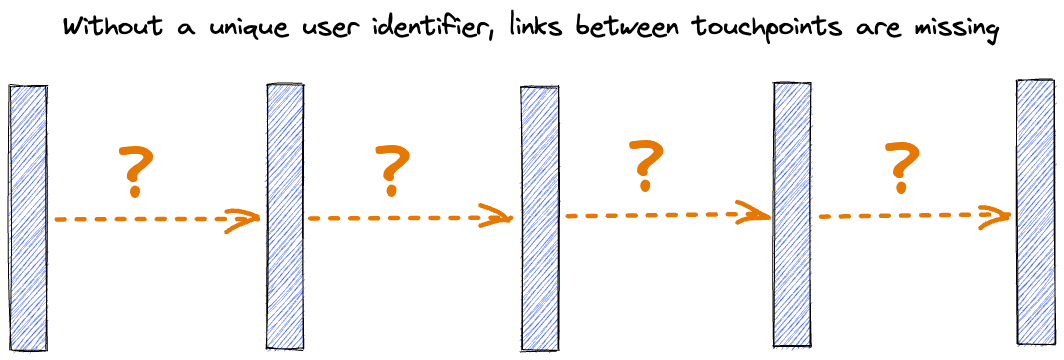How multi-touch attribution improves conversion and reduces customer acquisition costs for ecommerce brands
For a long time, brands have dreamt of getting a bird’s-eye view of their customer journey, with the goal of gleaning insights into where their customers come from, how they interact with marketing channels and campaigns, when they convert and why. From those insights, brands can take action: doubling down on the tactics and channels that bring in the most valuable customers, and discarding those that burn cash and resources. As signs emerge that the economy is worsening and brands continue to tighten their belts, this bird’s-eye view of the shopper journey is more relevant and essential for success than ever.

Some brands have been able to get close to this 10,000 ft. view of their businesses with years of investment in data analytics. However, with privacy changes in iOS and cookies sunsetting, connecting the dots along every customer journey becomes more and more challenging. Now even the most tech-savvy brands struggle to uncover which marketing campaign motivated a consumer to make a purchase.
The challenge: Customer acquisition cost continues to skyrocket 🚀
Privacy changes in iOS and the lack of cookies don’t keep ads from reaching their target audiences. However, they do add difficulties to marketing attribution. Without Apple Identifier for Advertisers (IDFA) and cookies, ad platforms like Facebook can no longer tie a conversion to specific ads.
So how do brands solve the puzzle and discover the most effective places to put their marketing dollars to work? Before we dive in, let’s look at the following example to review what marketing attribution is.

A preface to the solution: Marketing attribution 101
When I first moved to the Bay Area, I wanted to buy an air purifier to deal with the possible air quality problem from wildfires. Knowing little about air purifiers, I started my research with YouTube videos, reading review articles and listening to what influencers had to say. Once I felt informed about what made a good air purifier, I went ahead and searched for the best options – comparing product specs from brands’ websites, Amazon, etc. Finally, I decided to go with Brand 2 as shown in the chart below.
Among all the touchpoints, Youtube Paid Video 1 and Reddit Review Article 2 drove my purchase from Brand 2. But how can Brand 2 know those two touchpoints moved the needle in my case? That’s where marketing attribution comes in.
In practice, marketing attribution relies on technology that:
- Collects shopper clickstream data on touchpoints,
- Pieces disparate touchpoint data to construct a holistic shopper journey and
- Assigns credits for conversion to each touchpoint
Due to the technical challenges this end-to-end visibility often creates, most brands make marketing decisions based on first-touch or last-touch attribution alone. As a result, their marketing resource allocation is suboptimal at best. Luckily, machine learning provides a solution to multi-touch attribution.

How machine learning can improve your conversion rate
In the air purifier example, tens of thousands of shoppers interact with Brand 2 every day. At each touchpoint, the data system collects hundreds of shopper attributes and constructs shopper profiles. Each shopper profile serves as an identifier when IDFA, Android ID or cookies are not in place.

Later, machine learning algorithms leverage the shopper profiles, and automatically group shoppers who have gone through the same path into a cohort, as illustrated in Cohort 1, Cohort 2 and Cohort 3 below. Let’s say Cohort 1 brings in $1,000 of revenue. To understand Youtube Campaign B1’s performance, algorithms find all cohorts that have seen Youtube Campaign B1, and pair each cohort with a counterpart—where one touchpoint is different from the others—as illustrated in Cohort 1.1.1 vs Cohort 1.1.2 and Cohort 1.2.1 vs. Cohort 1.2.2.

In each pair, algorithms calculate the conversion delta and assign credits to Youtube Campaign B1. By iterating the process and summing Youtube Campaign B1’s conversion in each cohort, we get the campaign’s total conversion.
In the current economic climate, multi-touch attribution is more relevant than ever.
Eager to help brands grow faster with a simpler data stack, Cart.com built Unified Analytics – giving them the long-awaited bird’s-eye view of their shopper journey, powered by multi-touch attribution. Understanding that each product attracts different customers, Unified Analytics + Cart Pixel take attribution one step further, all the way down to the product level. With these superior insights, brands can now fuel the channels and campaigns that drive conversion and cut back on the campaigns that simply aren’t driving revenue.
Over the past two years, Unified Analytics has helped more than 30 brands optimize their ad spend and increase margins up to 20%.
Watch this video to see how Cart Unified Analytics can help you increase conversions, and see what our customers have to say:
“We spend a lot of time maintaining our data and it seems pretty fragile. Leveraging an expert partner who does this automatically and for a living should improve our effectiveness.” – Dallin Ferrin, VP Optimal Health Systems
Schedule your demo with a Unified Analytics expert now.
Or, complete the form below to talk with us about one or more ecommerce solutions:






